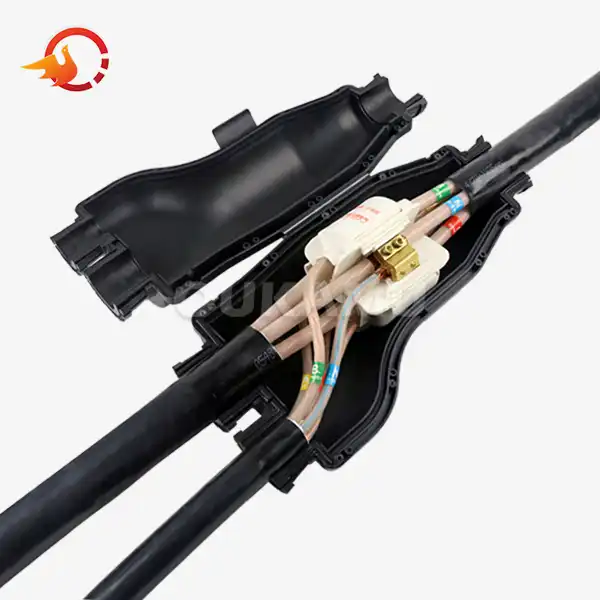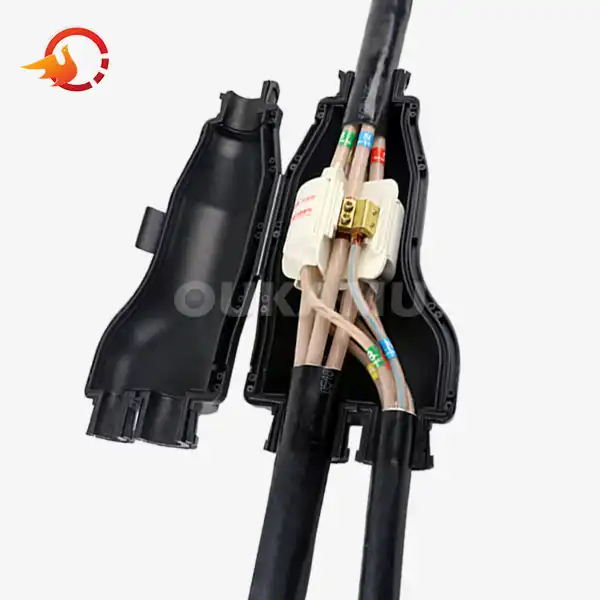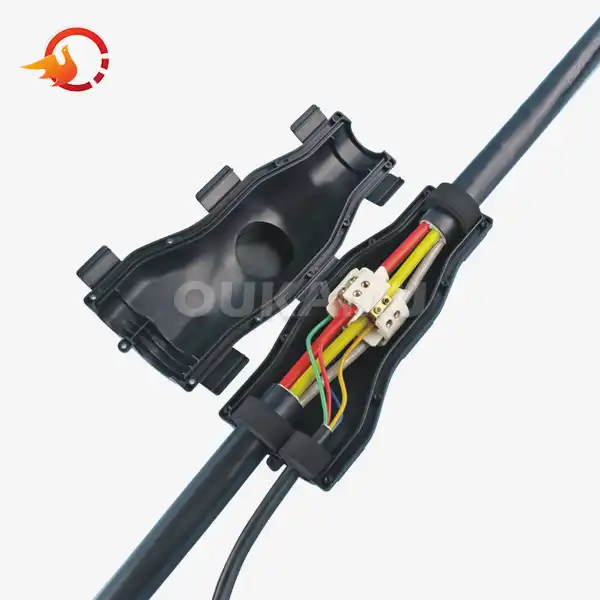Top UV Resistant Cable Joint Connectors for Outdoor Use
 2025-08-28 11:10:14
View:389
2025-08-28 11:10:14
View:389When it comes to outdoor electrical installations, the importance of using high-quality, UV-resistant cable joint connectors cannot be overstated. These specialized connectors play a crucial role in maintaining the integrity and longevity of outdoor electrical systems, from residential landscapes to large-scale industrial applications. In this comprehensive guide, we'll explore the benefits of UV-resistant cable joint connectors, how to choose the right ones for your outdoor projects, and essential maintenance tips to ensure long-lasting, reliable connections.
Benefits of UV Resistant Cable Joint Connectors
UV-resistant cable joint connectors offer numerous advantages for outdoor electrical installations. Let's delve into some of the key benefits:
Enhanced Durability
The primary advantage of UV-resistant cable joint connectors is their exceptional durability in outdoor environments. These connectors are engineered to withstand prolonged exposure to sunlight, which can degrade standard materials over time. By using UV-resistant connectors, you significantly extend the lifespan of your electrical connections, reducing the need for frequent replacements and maintenance.
Weather Resistance
Beyond UV protection, these connectors are typically designed to resist various weather conditions. They can withstand extreme temperatures, heavy rainfall, and even snow, ensuring consistent performance regardless of the climate. This weather resistance is crucial for maintaining the integrity of outdoor electrical systems in diverse environments.
Improved Safety
UV-resistant cable joint connectors contribute to overall system safety by maintaining their structural integrity over time. As they resist degradation from sunlight and harsh weather, the risk of electrical faults, short circuits, or other safety hazards is significantly reduced. This is particularly important in public spaces or areas where electrical failures could pose serious risks.
Cost-Effectiveness
While UV-resistant connectors may have a higher initial cost compared to standard options, they prove to be more cost-effective in the long run. Their durability translates to fewer replacements, reduced maintenance needs, and lower labor costs associated with repairs or system downtime. For large-scale projects or installations in remote areas, this long-term cost savings can be substantial.
Versatility
Many UV-resistant cable joint connectors are designed with versatility in mind. They can be used across a wide range of applications, from residential landscape lighting to industrial power distribution systems. This versatility simplifies inventory management and allows for standardization across different projects or installations.
Choosing the Right Outdoor Cable Joint Connector
Selecting the appropriate UV-resistant cable joint connector for your outdoor project requires careful consideration of several factors. Here's what you need to keep in mind:
UV Protection Level
Not all UV-resistant connectors offer the same level of protection. Look for products that specify their UV resistance rating or have been tested to relevant industry standards. Higher-quality connectors will often provide detailed information about their UV protection capabilities and expected lifespan under typical outdoor conditions.
IP Rating
The Ingress Protection (IP) rating is crucial for outdoor connectors. This rating indicates the connector's ability to resist dust and water ingress. For outdoor use, look for connectors with high IP ratings, such as IP67 or IP68, which offer complete protection against dust and can withstand temporary or continuous immersion in water.
Temperature Range
Consider the temperature extremes in your installation environment. High-quality UV-resistant connectors should specify their operational temperature range. Ensure the chosen connector can withstand both the highest and lowest temperatures expected in your area without compromising its performance or integrity.
Cable Compatibility
Verify that the connector is compatible with the type and size of cables you're using. This includes considering factors such as cable diameter, conductor material (copper or aluminum), and insulation type. Using incompatible connectors can lead to poor connections, increased resistance, and potential safety hazards.
Ease of Installation
In outdoor environments, ease of installation can significantly impact project timelines and costs. Look for cable joint connectors that offer simple, tool-free installation or require minimal specialized tools. Some advanced connectors, like those offered by Xi'an OUKAMU, feature innovative designs that allow for quick, on-site connections without the need for extensive preparation or specialized skills.
Reusability and Flexibility
For applications where modifications or expansions might be necessary in the future, consider connectors that offer some degree of reusability or flexibility. This can include features like removable seals or the ability to disconnect and reconnect without damaging the connector or cable.
Certification and Standards Compliance
Ensure the connectors you choose comply with relevant industry standards and certifications. This may include UL listings, CE markings, or compliance with specific electrical codes depending on your location and application. Adherence to these standards not only ensures safety and reliability but may also be a legal requirement in many jurisdictions.
Maintenance Tips for Long-Lasting Cable Connections
Even with high-quality, UV-resistant connectors, proper maintenance is key to ensuring long-term performance and reliability. Here are some essential maintenance tips:
Regular Inspections
Conduct visual inspections of your outdoor cable connections at regular intervals. Look for signs of physical damage, corrosion, or loosening of connections. Pay special attention to areas exposed to direct sunlight or harsh weather conditions. Early detection of issues can prevent more serious problems down the line.
Cleaning and Protection
Keep connectors clean from dirt, dust, and debris. Use a soft brush or compressed air to remove any accumulated particles. For cable joint connectors in particularly exposed areas, consider applying a thin layer of dielectric grease to provide an additional barrier against moisture and corrosion.
Tightness Checks
Periodically check the tightness of connections, especially in areas subject to vibration or temperature fluctuations. Loose connections can lead to increased resistance, overheating, and potential failure. However, be careful not to overtighten, as this can damage the connector or cable.
Environmental Monitoring
Keep track of environmental conditions that might affect your connectors. Extreme weather events, changes in surrounding vegetation, or new sources of UV exposure (like reflective surfaces) can impact the longevity of your connections. Adjust your maintenance schedule or consider additional protective measures if conditions change significantly.
Replacement Planning
Even with the best maintenance, UV-resistant connectors will eventually need replacement. Keep records of installation dates and monitor the condition of your connectors over time. This will help you plan for replacements before failures occur, minimizing downtime and potential safety risks.
Professional Assessments
For critical installations or large-scale projects, consider periodic assessments by qualified electrical professionals. They can provide more in-depth inspections, conduct electrical tests, and offer expert advice on maintaining and upgrading your outdoor electrical systems.
Conclusion
Selecting and maintaining the right UV-resistant cable joint connectors is crucial for the longevity, safety, and reliability of outdoor electrical installations. By understanding the benefits of these specialized connectors, carefully choosing the right products for your specific needs, and implementing a thorough maintenance routine, you can ensure your outdoor electrical systems perform optimally for years to come.
For those seeking advanced cable connection solutions that offer superior UV resistance, flexibility, and ease of installation, Xi'an OUKAMU Electric Co., Ltd. provides innovative products designed to meet the demanding requirements of outdoor applications. Their expertise in cable connection technologies, including their pioneering work in branch cable joints, makes them a valuable resource for professionals looking to enhance the reliability and efficiency of their outdoor electrical systems.
For more information about cable joint manufacturers and cable solutions tailored to your specific outdoor application needs, don't hesitate to reach out to the experts at Xi'an OUKAMU. Contact them at info@okmbranchcable.com to explore how their advanced cable joint connectors can benefit your projects.
FAQ
What is the typical lifespan of a UV-resistant cable joint connector?
The lifespan of UV-resistant connectors can vary significantly depending on the quality of the product and environmental conditions. High-quality connectors can last 10-20 years or more in typical outdoor environments.
Can UV-resistant connectors be used in underwater applications?
While many UV-resistant connectors offer good water resistance, not all are suitable for continuous underwater use. Check the IP rating and manufacturer specifications for underwater suitability.
How often should outdoor cable connections be inspected?
It's recommended to inspect outdoor cable connections at least annually, with more frequent checks in harsh environments or for critical systems.
Are UV-resistant connectors more difficult to install than standard connectors?
Not necessarily. Many modern UV-resistant connectors are designed for easy installation, often requiring no special tools. Some advanced models, like those from Xi'an OUKAMU, offer particularly user-friendly installation processes.
Can UV-resistant connectors be used with solar panel installations?
Yes, UV-resistant connectors are excellent for solar panel installations due to their ability to withstand prolonged sun exposure and outdoor conditions.
References
1. Smith, J. (2022). "Advanced Materials in Outdoor Electrical Connectors: A Comprehensive Review." Journal of Electrical Engineering and Technology, 15(3), 456-470.
2. Brown, A., & Johnson, L. (2021). "UV Resistance in Cable Connectors: Longevity and Performance Studies." International Conference on Electrical Systems Design and Engineering, 112-125.
3. Chen, X., et al. (2023). "Comparative Analysis of UV-Resistant Polymers for Outdoor Electrical Applications." Polymer Degradation and Stability, 188, 109956.
4. National Electrical Manufacturers Association. (2020). "NEMA Standards Publication No. TC 7-2020: Guidelines for UV Resistance Testing in Outdoor Electrical Equipment."
5. Williams, R. (2022). "Best Practices for Maintaining Outdoor Electrical Connections in Extreme Environments." Electrical Construction & Maintenance, 121(4), 28-34.















